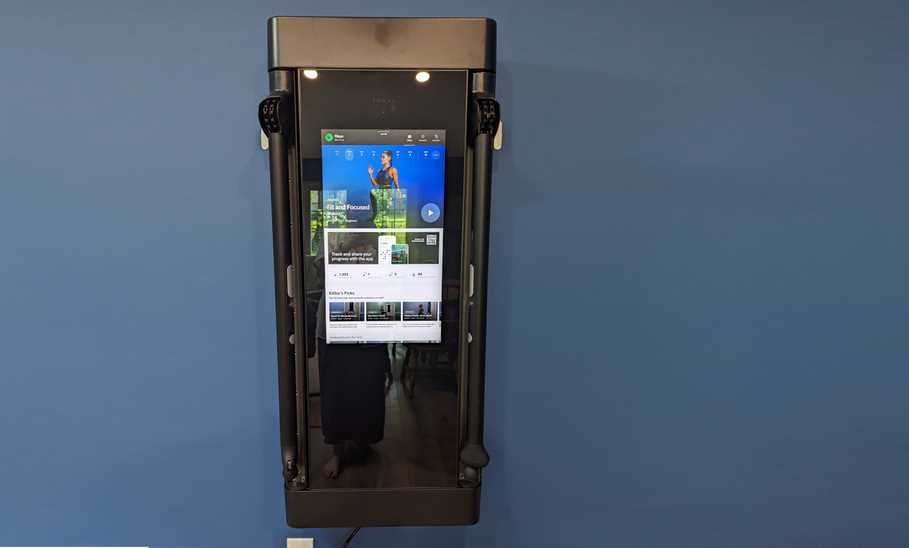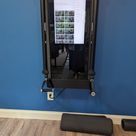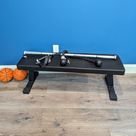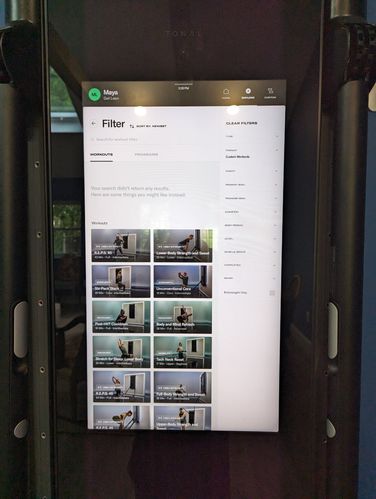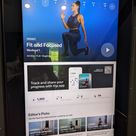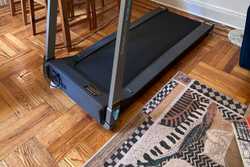During the pandemic, home gyms got a workout. When safety precautions were lifted and people could return to working out in groups, many did, but some—my family included—decided to stick with working out at home. Aly Orady, former CEO (she stepped down in 2023 to become its chief technology officer), designed the Tonal, which uses digital resistance mechanisms, electromagnetics, algorithms, and a cable machine to create a product that is a weight training machine plus personal trainer, all in one sleek package.
Last winter, I was lucky to get a deal on a Tonal Smart Home Gym. This popular, but expensive, home gym is a high-tech option with over 20 virtual trainers/coaches to guide your workout. I was skeptical when it arrived, but I’ve come to enjoy trying out the classes and programs.
Unboxing and first impressions
Unlike a treadmill or exercise bike, Tonal is delivered and set up by their professional installation team, who mount the machine vertically and set it up on the wall for you. There isn’t any unboxing, and the process is smooth, taking about 30 minutes to get the equipment safely onto the wall. Your wall will need to be sound, because the installers will need to find the studs in the wall.
You don’t do anything yourself other than have the wall space, which is a bonus from my perspective. It was also a relief not to be worried that the machine wasn’t safely connected because the professionals set it up.
The machine looks like a long mirror, and it’s powered by electromagnets. On either side of the screen, there are two adjustable arms. “It looks a little like a robot,” remarked my youngest. The arms tuck into the sides of the screen and have handles at the end of them. The rectangular screen is a large, flat (24-inch) screen with touch capabilities. I loved that we didn’t need weights lying around and that one machine could provide all kinds of weights within it—it basically allows you to get a full body workout without a bunch of dumbbells to store.
Maya Dollarhide / Tonal look How I tested Tonal
First, you set up a user profile using the touch screen. The machine guides you through profile setup—your height and weight, fitness goals, etc. The machine uses a touch screen that looks like a 24-inch mirror, plus two arms with five rotation angles, five arm angles, and nine heights. A slider on the arm is used to change the height, and the rotation angle is used by hitting a button; just move the arm lever to move the incline of the arm.
At first, I was nervous about the machine, but it’s intuitive. When you’re in set-up mode, the trainer on the screen carefully walks you through how to pull out the arms, where to move them, and how to hook on any accessories, like handles, which use a T-lock or resistance bar that snaps into place. Make sure to use the control clip on the accessories—it’s a gray cover that fits around the Tonal accessories. The control clip will turn the motion sensor on and off.
I liked that you can stop and start the set-up mode or any of the classes that aren’t live. At first, I had to stop and start the directions to move the arms and cables. There are sensors on the machine that will show you how to line up the arms for the exercise you’re doing, so if I wasn’t sure they were in the right position, the touch screen would show me a graphic of where they needed to be lined up. I used demo mode a few times to get used to the setup to adjust the arms for each exercise; then I started my assessment.
After setting up Tonal, I spent a few weeks trying out different programs and classes, albeit not consistently. There are live classes, recorded classes, and on-demand classes. I didn’t try out the live classes due to my schedule, but I enjoyed trying a few different on-demand classes for beginners. I recently started a four-week Get Lean beginner program, which is useful because it tells me which days to work out and rest. Even having a home gym at my fingertips, it still takes time and motivation to use.
Tonal price
The Tonal costs around $3,495, but the brand frequently offers deals. You have to purchase the accessories pack separately from the machine. It costs $495 and includes smart handles, six-axis gyroscopes that track every rep, a smart bar, rope, workout bench, roller, and a workout mat.
If you just buy the machine, you can use some, but not all, of the programs. You really need the accessories bundle for a full experience. The professional installation is $250 (and you probably want to add a tip). Plus a membership to Tonal’s programming is $49 per month.
Tonal does sell certified refurbished machines and accessories, so check its website for pricing on those. You can also pay per month (around $73) for one. Is the high price tag worth it? Depending on how much your local gym membership costs and how many family members are going to use the Tonal (three in ours, so far), the cost may be astronomical up front but could easily pay off over time, especially if you use it daily.
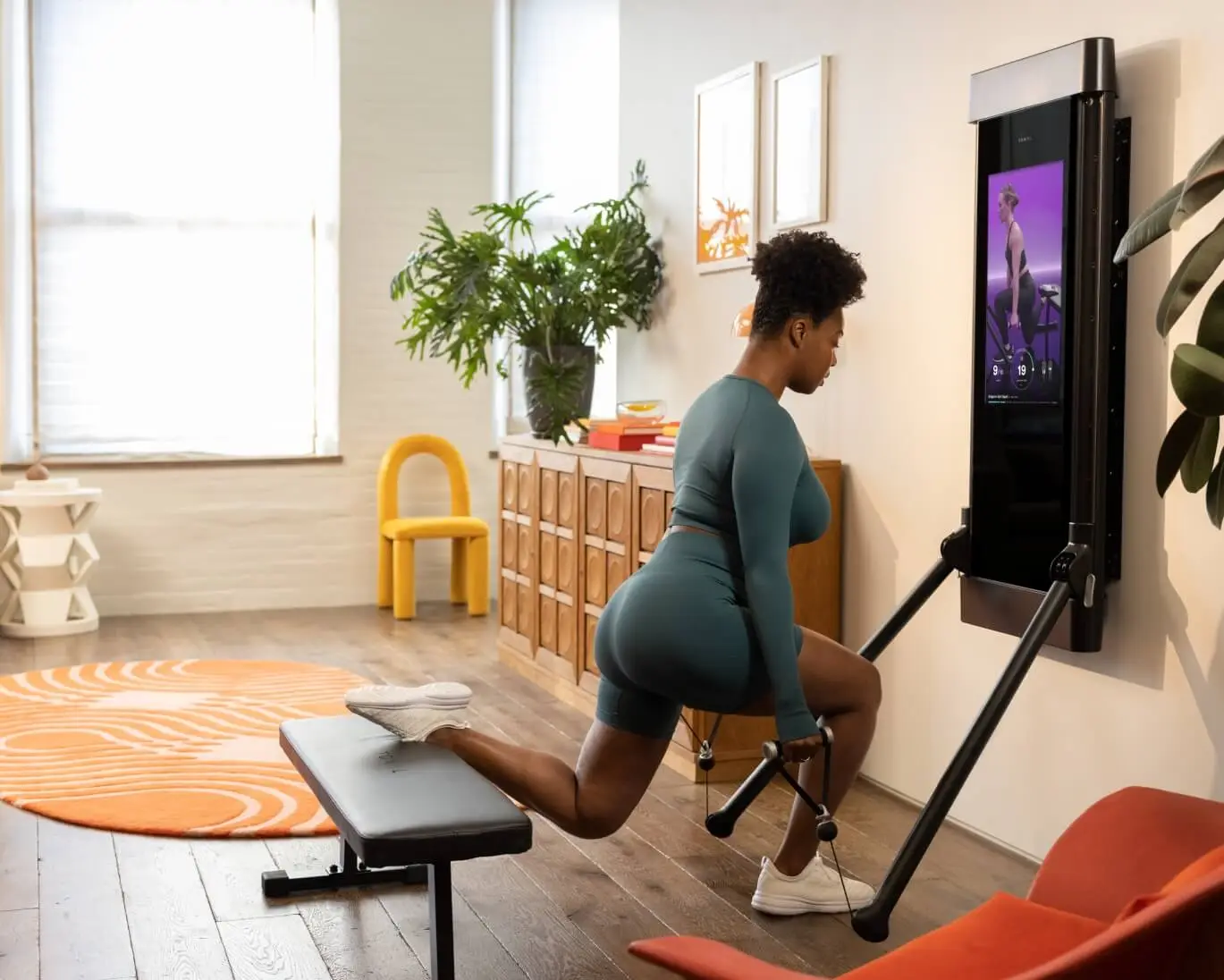
Tonal Smart Home Gym
Tonal Smart Home Gym specifications
- Footprint: Because this goes on the wall in a vertical position, the footprint is actually small. If you store your bench and basket of accessories, the footprint is nothing at all. It looks like a weird mirror, in my opinion.
- Resistance: Up to 200 pounds
- Space needed: According to the website: “The optimal space needed is 7 feet along your wall (3.5 feet on either side from the center of the machine) and 7 feet out from the wall. The optimal overhead height clearance is 7 feet 10 inches to allow Tonal’s adjustable arms to fully extend. However, Tonal can still operate with a ceiling height of 7 feet.”
- Power: Plugs in. You must have an outlet near the Tonal to use.
- Wi-Fi necessary: Yes
- Installation: Handled by the professionals. Whew.
- Trial period: 30 days
- Accessories: Must purchase a bundle of accessories separately
Tonal features
Tonal is similar to a smart mirror and touch screen with extendable arms, and offers personal training, on-demand workouts, strength training, yoga, and pilates classes. Here are some of its most popular features.
Ability to sense muscle fatigue
When you use the Tonal, it will show you how fatigued your muscles are getting as you do reps. This not only helps you gauge your strength and stamina, but it keeps you from hurting yourself. Based on information from your assessment and later your previous workouts, it can tell how fatigued each set of muscles is. The Tonal uses an easy-to-understand color coding system of green (good to go), yellow (you’re doing ok, but let’s be careful), and red (you need to rest this muscle set).
Classes and programs
Tonal comes with a huge workout library and offers over 60 programs along with 1,000 individual workouts by category, such as beginner, intermediate, and advanced fitness levels. You can also search by type of class and browse programs like HIIT, meditation, yoga, and good old-fashioned boot camps to find the best workout for your fitness goals. Some programs run four weeks, others two.
You can also mix and match your classes and workouts. For instance, I tried an arm strengthening program and then a yoga class the next day. So far, I like the programs because they give me a roadmap for a month of fitness and take the guesswork out of when to use the machine and when to rest. But I’m excited to try more of the on-demand classes.
The Tonal team updates its workouts and programs a few times a year, and you can choose between custom or guided workouts. Plus, you can download the Tonal app on your phone or tablet if you want to exercise when you're away, although you’ll have to stick to non-weight lifting options.
Dynamic weight modes
The Tonal offers 200 pounds of resistance, something I’ll likely never do, but home bodybuilders and those with high-strength focused workout routines will likely get use out of the high-weight resistance.
Tonal offers five dynamic weight modes to challenge your workouts: Spotter, Burnout, Eccentric, Smart Flex, and Chains. These are programmed into the workouts, or you can activate them on your screen.
- Spotter: Reduces the weight automatically if you’re struggling so you can finish your reps. So far, I’ve only used the Spotter mode as a beginner. In addition, the spotter is always on default, so you don’t get injured.
- Smart Flex: This mode adjusts the resistance in real time, adapting to your abilities as you perform your reps. It may increase or decrease depending on your range of motion and strength.
- Eccentric: I still don’t fully understand this mode, having not been strong enough to use it, but the site states: “Tonal adjusts weight in the eccentric phase to be 25% heavier than your concentric load without hitting your max weight, which is consistent with research-backed recommendations.”
- Chains mode: Serious weight lifters use chains hanging off the ends of barbells to increase the weight, and this mode mimics the feeling of chains, so it gets heavier as you lift up and lighter as you go down. In my opinion, it's not for beginners.
- Burnout: This mode is useful because it automatically reduces the digital weight when you’re struggling during a high-rep set, allowing you to keep going without stopping.
How to use Tonal
What I like about the Tonal is once it’s installed, you set up your profile and get your resistance assessment done. How you use the Tonal is up to you and your fitness level. The machine offers so many classes, programs, and ways to exercise with it that you can figure out the best way for you and create programs and workouts that will increase in difficulty as you get stronger. You can use Tonal for building muscle, strengthening your core, weight loss, improving mobility, and for all kinds of fitness goals.
There’s even a family mode so younger kids and teens can use the Tonal (with adult supervision) and enjoy working out, too. My kids haven’t tried it yet, but it’s on our list for summer.
Tonal provides a very high-end performance. We’ve had no issues with tech, like Bluetooth connectivity. I love how intuitive the touch screen is to use. The 14+ trainers are likable, and their presentations feel incredibly personalized for an on-demand class. You can play music through your Tonal as well. There are a dozen Tonal Radio stations, but the machine can also integrate with Apple Music’s library or your own.
One complaint from users (although not me) is that you do have to switch out accessories and change arm directions (manually) if you’re doing a mix of series of upper and lower body. I need the practice of clicking the arms into place (depending on the exercise) so I don’t mind. Plus, you don’t move the arms until you change the exercise, and your virtual trainer will tell you exactly when and how you need to set them up

Tonal Smart Home Gym
Tonal: Is it for you?
Tonal user experience
The Tonal setup is relatively simple—it’s guided on the screen, plus you can stop and start if you get confused about something. The user interface touch screen is extremely simple, and you can search everything easily, including via fitness level, types of classes, fitness goals, etc.. I like that there are a ton of options for beginners. In addition, you can choose shorter or longer sessions depending on how much time you have.
The instructors are direct and friendly and emphasize form. The Tonal will alert you to any mistakes you’re making, plus there are safety modes built in so you don’t get hurt when you lift. So far, I’ve only tried a few of the 1000+ on-demand classes and started one program, but I’ve enjoyed all the beginner sessions. Each time I use the Tonal, I feel more confident about the next session.
I appreciate that you can listen to your own music, or enjoy the Tonal playlist in class. It’s easy not to skip a day because it’s “right there” versus getting in the car and driving to the gym. If you love the energy of a group or crowd at a gym, you may find having just you and a virtual fitness coach a little lonely at times. Personally, I enjoy working out by myself, so this isn’t an issue. However, I also sometimes take barre, HIIT, and pilates classes in person at a local recreation center and a wellness studio, so the programs on the Tonal are a nice complement to other exercises that I enjoy with live instructors whom I trust and love.
Tonal will definitely improve your fitness (if you use it regularly), and you can easily level up and try new workouts without risking injury due to the safety mechanisms built into it. I’m still new on my Tonal journey, but I’m looking forward to putting it to more use in the coming months.
Tonal pros and cons
Pros:
- Installation is done by professionals
- Over 1000 workouts and over 60 programs (beginner, intermediate, and advanced) to keep things interesting
- Tonal prioritizes safety features
- Two-year warranty (must be professionally installed)
- Easy and intuitive touch screen
- No need for multiple weights
- Isn’t bulky like many workout machines and has a small footprint
Cons:
- Expensive
- Your wall has to meet the requirements to safely put up the Tonal
- You have to have the wall and floor space (for when you exercise)
- It’s a solo experience
Safety and lifting modes
Because the Tonal is professionally installed, you don’t have to worry about it falling off the wall. The artificial intelligence built into the machine and adaptive weight features mean the machine can be safely used because you can turn off the weight with the click of a button, unlike using free weights. As mentioned earlier, there are five lifting modes, and all of them have a built-in Spotter mode, so you can quit if you need to.
In addition, according to the website: “Tonal uses its sensor technology to track your pace, range of motion, positioning, and balance to give you real-time cues on your form, just like a personal trainer.” I found this to all be true, as the Tonal alerted me when my form was drooping or dialed back the weight when I lost my form. The real-time cues made a huge difference in my not injuring myself by continuously using an incorrect form or struggling with a weight that was too high for me because it also automatically adjusts based on your assessment. I used Spotter mode for all my courses and found it worked. As I gain more confidence with the machine, I’m sure I will try other modes.
Design and build quality
The design is state-of-the-art, sleek, and operates smoothly. You need Wi-Fi to operate the Tonal, so make sure you place it where you don’t have dropped connections. The touch screen is easy to use, and the cables slide easily in and out. Other than your trainer yelling from your screen and the music, the machine is quiet. We haven’t had it long enough to find out if there is wear and tear, but I doubt it, judging from the rave reviews the machine has received since its inception.
Total alternatives
Lululemon Studio Mirror
There are other smart at-home gyms similar to Tonal, including the Lululemon Studio Mirror (formerly just called Mirror before its partnership), which looks to me like a Tonal without the arms and lies a bit flatter on the wall. The Lululemon Studio Mirror is more affordable (comes in at around $1,500 plus membership) and comes with a wall mount and stand, resistance bands, and a heart-rate monitor.
You can buy other accessories for it, and with your all-access membership, you’ll get access to a library of 1000+ workouts. Lululemon has partnered with Peloton, so you get access to its library without having to have a Peloton membership. Bonus: According to users, you can see your instructor and yourself while working out, and it acts as a regular mirror when not in use.
Tempo Studio
Another alternative is Tempo Studio, which consists of actual barbells and other accessories, plus a free-standing frame with storage, and a 3-D camera that will “map where and how you work out,” according to the website. The Tempo smart features can offer you real-time guidance plus three studio options (lite, trainer, and pro trainer) so you can start at any level. The Tempo doesn’t attach to a wall, so you’ll need the floor space for it, but like Tonal and Mirror, it uses a screen.
Plus, with its app, you can plan your workouts around your personal biometric data, including activity levels, how much you have slept, and your heart rate. For another layer of assessment and tracking, you might find it helpful to combine the Tonal with a smartwatch or fitness tracker.
Final verdict
At the end of the day, I wouldn’t have purchased our Tonal. It was something my husband was interested in, and he got a good deal on it. If you have the money and the wall space, and you want to lift weights without having to own any, plus have access to a smart home gym, the Tonal is a great choice. I’m impressed by its wide range of features, like the ability to track your workout, form recommendations, customizable workouts, and ease of use, plus a large library of classes and programs. I love how easy it is to use, the variety of programs, and that someone like me, without a lot of fitness knowledge, is building confidence and strength in a safe way.
In addition, given its safety features, it makes it a solid, although pricey, option for families with older children and teens who might want to take classes or learn more about weight training. This is a high-tech machine that takes up limited space, which is also a bonus. You can try it for up to 30 days. If you’re not satisfied, you can get your money and your wall space back. If it seems too pricey for your budget, there are other smart-home options for less. You might just not get as many bells and whistles.

Tonal Smart Home Gym
